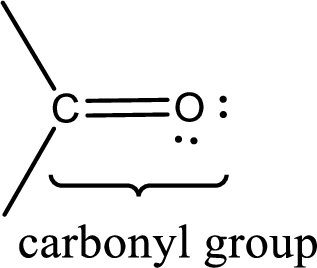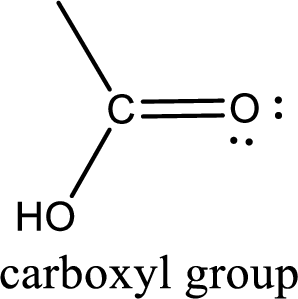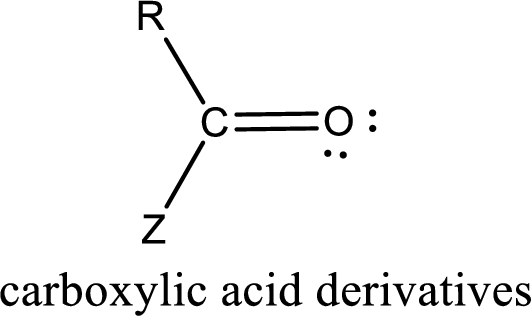
General, Organic, and Biological Chemistry
7th Edition
ISBN: 9781285853918
Author: H. Stephen Stoker
Publisher: Cengage Learning
expand_more
expand_more
format_list_bulleted
Concept explainers
Question
Chapter 16.1, Problem 5QQ
Interpretation Introduction
Interpretation:
The
Concept Introduction:
Carbonyl groups are the one which contain a double bond between carbon and oxygen atom.

If a hydroxyl group is attached to a carbonyl group means it is known as carboxyl group. This can be represented as shown below,

Carboxylic acid derivatives are the ones that are synthesized from or converted to a carboxylic acid. The generalized structural representation of carboxylic acid derivatives is shown below,

Expert Solution & Answer
Want to see the full answer?
Check out a sample textbook solution
Students have asked these similar questions
When talking about the acidity of carboxylic acids, is it the same thing to say higher or stronger acidity?
Using the following two half-reactions, determine the pH range in which $NO_2^-\ (aq)$ cannot be found as the predominant chemical species in water.* $NO_3^-(aq)+10H^+(aq)+8e^-\rightarrow NH_4^+(aq)+3H_2O(l),\ pE^{\circ}=14.88$* $NO_2^-(aq)+8H^+(aq)+6e^-\rightarrow NH_4^+(aq)+2H_2O(l),\ pE^{\circ}=15.08$
Indicate characteristics of oxodec acid.
Chapter 16 Solutions
General, Organic, and Biological Chemistry
Ch. 16.1 - Prob. 1QQCh. 16.1 - Prob. 2QQCh. 16.1 - Prob. 3QQCh. 16.1 - Prob. 4QQCh. 16.1 - Prob. 5QQCh. 16.2 - Prob. 1QQCh. 16.2 - Prob. 2QQCh. 16.2 - Prob. 3QQCh. 16.2 - Prob. 4QQCh. 16.2 - Prob. 5QQ
Ch. 16.3 - Prob. 1QQCh. 16.3 - Prob. 2QQCh. 16.3 - Prob. 3QQCh. 16.4 - Prob. 1QQCh. 16.4 - Prob. 2QQCh. 16.4 - Prob. 3QQCh. 16.5 - Prob. 1QQCh. 16.5 - Prob. 2QQCh. 16.5 - Prob. 3QQCh. 16.6 - Prob. 1QQCh. 16.6 - Prob. 2QQCh. 16.7 - Prob. 1QQCh. 16.7 - Prob. 2QQCh. 16.7 - Prob. 3QQCh. 16.8 - Prob. 1QQCh. 16.8 - Prob. 2QQCh. 16.8 - Prob. 3QQCh. 16.8 - Prob. 4QQCh. 16.9 - Prob. 1QQCh. 16.9 - Prob. 2QQCh. 16.10 - Prob. 1QQCh. 16.10 - Prob. 2QQCh. 16.11 - Prob. 1QQCh. 16.11 - Prob. 2QQCh. 16.11 - Prob. 3QQCh. 16.12 - Prob. 1QQCh. 16.12 - Prob. 2QQCh. 16.12 - Prob. 3QQCh. 16.12 - Prob. 4QQCh. 16.13 - Prob. 1QQCh. 16.13 - Prob. 2QQCh. 16.14 - Prob. 1QQCh. 16.14 - Prob. 2QQCh. 16.14 - Prob. 3QQCh. 16.15 - Prob. 1QQCh. 16.15 - Prob. 2QQCh. 16.15 - Prob. 3QQCh. 16.16 - Prob. 1QQCh. 16.16 - Prob. 2QQCh. 16.16 - Prob. 3QQCh. 16.17 - Prob. 1QQCh. 16.17 - Prob. 2QQCh. 16.18 - Prob. 1QQCh. 16.18 - Prob. 2QQCh. 16.18 - Prob. 3QQCh. 16.19 - Prob. 1QQCh. 16.19 - Prob. 2QQCh. 16.19 - Prob. 3QQCh. 16.19 - Prob. 4QQCh. 16.20 - Prob. 1QQCh. 16.20 - Prob. 2QQCh. 16.20 - Prob. 3QQCh. 16.20 - Prob. 4QQCh. 16 - Prob. 16.1EPCh. 16 - Prob. 16.2EPCh. 16 - Prob. 16.3EPCh. 16 - Prob. 16.4EPCh. 16 - Prob. 16.5EPCh. 16 - Prob. 16.6EPCh. 16 - Prob. 16.7EPCh. 16 - Prob. 16.8EPCh. 16 - Prob. 16.9EPCh. 16 - Prob. 16.10EPCh. 16 - Prob. 16.11EPCh. 16 - Prob. 16.12EPCh. 16 - Prob. 16.13EPCh. 16 - Prob. 16.14EPCh. 16 - Prob. 16.15EPCh. 16 - Prob. 16.16EPCh. 16 - Prob. 16.17EPCh. 16 - Prob. 16.18EPCh. 16 - Prob. 16.19EPCh. 16 - Prob. 16.20EPCh. 16 - Prob. 16.21EPCh. 16 - Prob. 16.22EPCh. 16 - Prob. 16.23EPCh. 16 - Prob. 16.24EPCh. 16 - Prob. 16.25EPCh. 16 - Prob. 16.26EPCh. 16 - Prob. 16.27EPCh. 16 - Prob. 16.28EPCh. 16 - Prob. 16.29EPCh. 16 - Prob. 16.30EPCh. 16 - Prob. 16.31EPCh. 16 - Prob. 16.32EPCh. 16 - Prob. 16.33EPCh. 16 - Prob. 16.34EPCh. 16 - Prob. 16.35EPCh. 16 - Prob. 16.36EPCh. 16 - Prob. 16.37EPCh. 16 - Prob. 16.38EPCh. 16 - Prob. 16.39EPCh. 16 - Prob. 16.40EPCh. 16 - Determine the maximum number of hydrogen bonds...Ch. 16 - Prob. 16.42EPCh. 16 - Prob. 16.43EPCh. 16 - Prob. 16.44EPCh. 16 - Prob. 16.45EPCh. 16 - Prob. 16.46EPCh. 16 - Prob. 16.47EPCh. 16 - Prob. 16.48EPCh. 16 - Prob. 16.49EPCh. 16 - Prob. 16.50EPCh. 16 - Prob. 16.51EPCh. 16 - Prob. 16.52EPCh. 16 - Prob. 16.53EPCh. 16 - Prob. 16.54EPCh. 16 - Prob. 16.55EPCh. 16 - Prob. 16.56EPCh. 16 - Give the IUPAC name for each of the following...Ch. 16 - Give the IUPAC name for each of the following...Ch. 16 - Prob. 16.59EPCh. 16 - Give the common name for each of the carboxylic...Ch. 16 - Prob. 16.61EPCh. 16 - Write a chemical equation for the preparation of...Ch. 16 - Prob. 16.63EPCh. 16 - Prob. 16.64EPCh. 16 - Prob. 16.65EPCh. 16 - Prob. 16.66EPCh. 16 - Prob. 16.67EPCh. 16 - Prob. 16.68EPCh. 16 - Prob. 16.69EPCh. 16 - Prob. 16.70EPCh. 16 - Prob. 16.71EPCh. 16 - Prob. 16.72EPCh. 16 - Prob. 16.73EPCh. 16 - Prob. 16.74EPCh. 16 - Prob. 16.75EPCh. 16 - Prob. 16.76EPCh. 16 - Prob. 16.77EPCh. 16 - Prob. 16.78EPCh. 16 - Prob. 16.79EPCh. 16 - Prob. 16.80EPCh. 16 - Prob. 16.81EPCh. 16 - Prob. 16.82EPCh. 16 - Prob. 16.83EPCh. 16 - Prob. 16.84EPCh. 16 - Prob. 16.85EPCh. 16 - Prob. 16.86EPCh. 16 - Prob. 16.87EPCh. 16 - Prob. 16.88EPCh. 16 - Prob. 16.89EPCh. 16 - Prob. 16.90EPCh. 16 - Prob. 16.91EPCh. 16 - Prob. 16.92EPCh. 16 - Assign an IUPAC name to each of the following...Ch. 16 - Prob. 16.94EPCh. 16 - Prob. 16.95EPCh. 16 - Prob. 16.96EPCh. 16 - Prob. 16.97EPCh. 16 - Prob. 16.98EPCh. 16 - Prob. 16.99EPCh. 16 - Prob. 16.100EPCh. 16 - How many carbon atoms are present in a molecule of...Ch. 16 - Prob. 16.102EPCh. 16 - Prob. 16.103EPCh. 16 - Prob. 16.104EPCh. 16 - Prob. 16.105EPCh. 16 - Prob. 16.106EPCh. 16 - Prob. 16.107EPCh. 16 - Prob. 16.108EPCh. 16 - Prob. 16.109EPCh. 16 - Prob. 16.110EPCh. 16 - Prob. 16.111EPCh. 16 - Prob. 16.112EPCh. 16 - Prob. 16.113EPCh. 16 - Prob. 16.114EPCh. 16 - Prob. 16.115EPCh. 16 - Prob. 16.116EPCh. 16 - Prob. 16.117EPCh. 16 - Prob. 16.118EPCh. 16 - Prob. 16.119EPCh. 16 - Prob. 16.120EPCh. 16 - Prob. 16.121EPCh. 16 - Prob. 16.122EPCh. 16 - Prob. 16.123EPCh. 16 - Prob. 16.124EPCh. 16 - Prob. 16.125EPCh. 16 - Prob. 16.126EPCh. 16 - Prob. 16.127EPCh. 16 - Prob. 16.128EPCh. 16 - Prob. 16.129EPCh. 16 - Prob. 16.130EPCh. 16 - Prob. 16.131EPCh. 16 - Prob. 16.132EPCh. 16 - Prob. 16.133EPCh. 16 - Prob. 16.134EPCh. 16 - Prob. 16.135EPCh. 16 - Prob. 16.136EPCh. 16 - Prob. 16.137EPCh. 16 - Prob. 16.138EPCh. 16 - Prob. 16.139EPCh. 16 - Prob. 16.140EPCh. 16 - Prob. 16.141EPCh. 16 - Prob. 16.142EPCh. 16 - Prob. 16.143EPCh. 16 - Prob. 16.144EPCh. 16 - Prob. 16.145EPCh. 16 - Prob. 16.146EPCh. 16 - Prob. 16.147EPCh. 16 - Prob. 16.148EPCh. 16 - Draw a condensed structural formula for the...Ch. 16 - Prob. 16.150EPCh. 16 - Prob. 16.151EPCh. 16 - Prob. 16.152EPCh. 16 - Prob. 16.153EPCh. 16 - Prob. 16.154EPCh. 16 - Prob. 16.155EPCh. 16 - Prob. 16.156EPCh. 16 - Prob. 16.157EPCh. 16 - Prob. 16.158EPCh. 16 - Prob. 16.159EPCh. 16 - Prob. 16.160EPCh. 16 - Prob. 16.161EPCh. 16 - Prob. 16.162EPCh. 16 - Prob. 16.163EPCh. 16 - Prob. 16.164EP
Knowledge Booster
Learn more about
Need a deep-dive on the concept behind this application? Look no further. Learn more about this topic, chemistry and related others by exploring similar questions and additional content below.Similar questions
- What is the final product when hexanedioic acid reacts with 1º PCl5 and 2º NH3.arrow_forwardWhat is the final product when D-galactose reacts with hydroxylamine?arrow_forwardIndicate the formula of the product obtained by reacting methyl 5-chloro-5-oxopentanoate with 1 mole of 4-penten-1-ylmagnesium bromide.arrow_forward
- The temperature on a sample of pure X held at 1.25 atm and -54. °C is increased until the sample boils. The temperature is then held constant and the pressure is decreased by 0.42 atm. On the phase diagram below draw a path that shows this set of changes. pressure (atm) 2 0 0 200 400 temperature (K) Xarrow_forwardQUESTION: Answer Question 5: 'Calculating standard error of regression' STEP 1 by filling in all the empty green boxes *The values are all provided in the photo attached*arrow_forwardpressure (atm) 3 The pressure on a sample of pure X held at 47. °C and 0.88 atm is increased until the sample condenses. The pressure is then held constant and the temperature is decreased by 82. °C. On the phase diagram below draw a path that shows this set of changes. 0 0 200 temperature (K) 400 аarrow_forward
arrow_back_ios
SEE MORE QUESTIONS
arrow_forward_ios
Recommended textbooks for you
 General, Organic, and Biological ChemistryChemistryISBN:9781285853918Author:H. Stephen StokerPublisher:Cengage Learning
General, Organic, and Biological ChemistryChemistryISBN:9781285853918Author:H. Stephen StokerPublisher:Cengage Learning Organic And Biological ChemistryChemistryISBN:9781305081079Author:STOKER, H. Stephen (howard Stephen)Publisher:Cengage Learning,
Organic And Biological ChemistryChemistryISBN:9781305081079Author:STOKER, H. Stephen (howard Stephen)Publisher:Cengage Learning,

General, Organic, and Biological Chemistry
Chemistry
ISBN:9781285853918
Author:H. Stephen Stoker
Publisher:Cengage Learning

Organic And Biological Chemistry
Chemistry
ISBN:9781305081079
Author:STOKER, H. Stephen (howard Stephen)
Publisher:Cengage Learning,